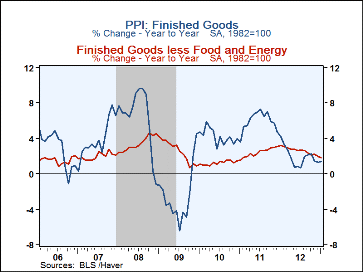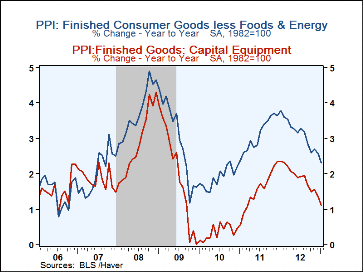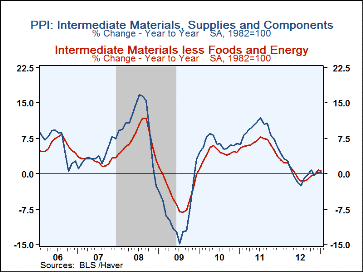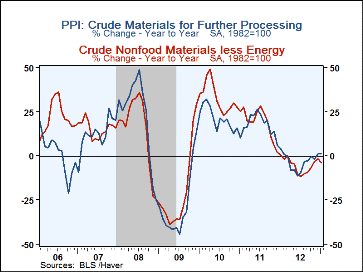 Global| Feb 20 2013
Global| Feb 20 2013U.S. PPI Increases Moderately
by:Tom Moeller
|in:Economy in Brief
Summary
The producer price index for finished goods gained 0.2% last month (1.4% y/y) after a revised 0.3% December fall. Expectations had been for a 0.4% increase. (Data back to 2008 were revised due to updated seasonal factors.) Prices [...]
The producer price index for finished goods gained 0.2% last month (1.4% y/y) after a revised 0.3% December fall. Expectations had been for a 0.4% increase. (Data back to 2008 were revised due to updated seasonal factors.) Prices excluding food & energy also rose an expected 0.2% (1.8% y/y) in January. A 0.7% rise (3.0% y/y) in food prices recovered their December drop while energy prices fell 0.4% (-0.9% y/y), down for the fourth straight month.
Finished consumer goods prices increased 0.2% (1.5% y/y) after three months of decline. Excluding food & energy, consumer goods prices jumped 0.4% (2.3% y/y). Within the components, men's apparel prices rose 4.5% y/y but women's clothing costs increased just 1.4% y/y. Household appliance prices gained 2.2% y/y, furniture prices rose 1.8% y/y and passenger car prices were unchanged y/y. Capital equipment prices ticked up 0.1% last month (1.1% y/y).
Intermediate goods prices were unchanged (0.4% y/y) as energy costs fell 0.3% (-2.2% y/y). Food prices were off 1.3% (+5.3% y/y). Core-intermediate prices rose a steady 0.3% (0.7% y/y. Crude goods prices jumped another 0.8% (1.4% y/y) last month as energy prices surged 2.3% (-1.5% y/y). Food prices fell 0.4% but still were up 8.5% y/y. Prices excluding food & energy fell 0.3% (-3.7% y/y).
The PPI data are contained in Haver's USECON database with further detail in PPI and PPIR. The expectations figures are available in the AS1REPNA database.
The Exchange Rate Disconnect from the Federal Reserve Bank of New York can be found here.
| Producer Price Index (%) | Jan | Dec | Nov | Jan Y/Y | 2012 | 2011 | 2010 |
|---|---|---|---|---|---|---|---|
| Finished Goods | 0.2 | -0.3 | -0.4 | 1.4 | 1.9 | 6.0 | 4.2 |
| Less Food & Energy | 0.2 | 0.1 | 0.2 | 1.8 | 2.6 | 2.4 | 1.2 |
| Foods | 0.7 | -0.8 | 1.3 | 3.0 | 2.5 | 6.3 | 3.9 |
| Energy | -0.4 | -0.6 | -3.3 | -0.9 | -0.2 | 15.5 | 13.5 |
| Intermediate Goods | 0.0 | 0.1 | -0.9 | 0.4 | 0.5 | 9.0 | 6.4 |
| Less Food & Energy | 0.3 | 0.3 | -0.1 | 0.7 | 0.3 | 6.2 | 4.3 |
| Crude Goods | 0.8 | 1.4 | 0.4 | 1.4 | -3.2 | 17.4 | 21.3 |
| Less Food & Energy | -0.3 | 1.4 | 1.3 | -3.7 | -5.2 | 18.5 | 32.5 |
Tom Moeller
AuthorMore in Author Profile »Prior to joining Haver Analytics in 2000, Mr. Moeller worked as the Economist at Chancellor Capital Management from 1985 to 1999. There, he developed comprehensive economic forecasts and interpreted economic data for equity and fixed income portfolio managers. Also at Chancellor, Mr. Moeller worked as an equity analyst and was responsible for researching and rating companies in the economically sensitive automobile and housing industries for investment in Chancellor’s equity portfolio. Prior to joining Chancellor, Mr. Moeller was an Economist at Citibank from 1979 to 1984. He also analyzed pricing behavior in the metals industry for the Council on Wage and Price Stability in Washington, D.C. In 1999, Mr. Moeller received the award for most accurate forecast from the Forecasters' Club of New York. From 1990 to 1992 he was President of the New York Association for Business Economists. Mr. Moeller earned an M.B.A. in Finance from Fordham University, where he graduated in 1987. He holds a Bachelor of Arts in Economics from George Washington University.










